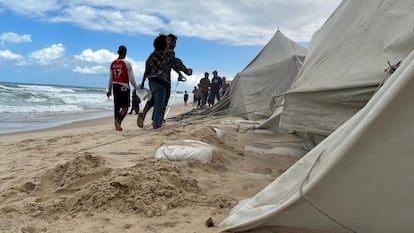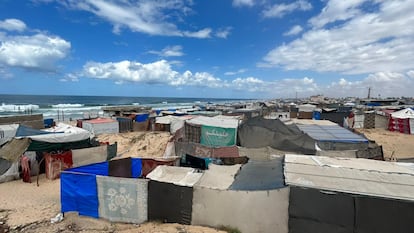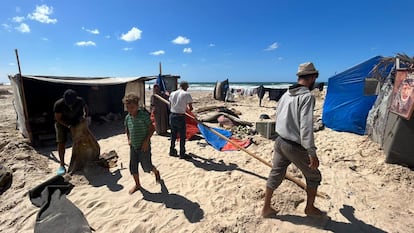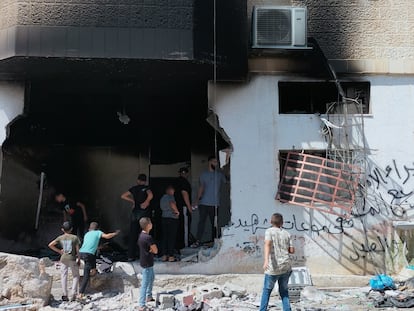Thousands of displaced people in Gaza live trapped between bombs and rising tides: ‘We could drown in our sleep’
Displaced Palestinian families in a coastal area in the southern Strip have their tents flooded by the sea and fear that their fragile shelters will not withstand the cold and winter rains

Hundreds of Palestinians who have found shelter near the sea in the Al Mawasi area in southern Gaza have had their tents flooded in recent days by the strong tides, which have swallowed up meters of beach and forced many displaced people to move again. Others, unable to find a more remote place to take shelter from the bombs or to afford the expense of moving again, are trying to prevent the water from damaging their few belongings or threatening the lives of their families.
Ahmed al-Zaqzuq has decided to leave. The 56-year-old had been watching for days as the waves were getting rougher and the sea line was drawing closer. Although he relocated his family of 10, including two grandchildren, meters further out, it was not enough and one day at dawn they woke up surrounded by water. “We came here to escape the bombs. It seemed the safest place from the Israeli bombings,” Al-Zaqzuq now laments, as he dismantles the remains of his small shelter on the beach near Khan Younis.
The Al Mawasi area is a strip of land located west of the towns of Khan Younis in the southern Strip and and Deir al-Balah, in the center, bordering the Mediterranean Sea. For weeks, the Israeli army has designated it as a “humanitarian” zone, which means that several hundred thousand people are crammed into 47 square kilometres (13% of the total area of the Strip) in deplorable conditions and without access to basic services. According to the United Nations, the population density of Al Mawasi is around 30,000 people per square kilometre, compared to 1,200 per square kilometre before the start of the war.
Most people fled from the southern tip of Gaza after Israel’s ground operation in the Rafah area on the border with Egypt began in May. According to the UN, 90% of Gaza’s 2.3 million inhabitants have been forced to move, most of them several times, since October 2023 when Hamas-led militants carried out bloody attacks that killed 1,200 people in Israel. Since then, Israel has relentlessly bombed Gaza and the death toll among Palestinians has now exceeded 41,000. The Strip is devastated. According to World Bank data from January, more than 60% of buildings and 80% of businesses have been destroyed. These figures have worsened since then, forcing a large part of the population to live in camps for displaced persons, such as Al Mawasi.
On September 14, a statement from the authorities in Gaza, which is under the control of Hamas, estimated that at least 74% of the tents in these camps are no longer in usable condition and need to be replaced immediately. Many of them have been put up and taken down several times due to forced displacement and have been worn down by the heat and sun of summer, leaving them unable to protect the population from the cold and wind in the coming winter.
We are cornered. On one side there is the Israeli army, which wants us dead, and on the other side there is our own sea, which is now drowning us”Ahmed al-Zaqzuq, displaced Palestinian

“We can’t stay here any longer”
Al-Zaqzuq cannot afford a new tent, which costs around $700, nor can he afford to renew the wooden beams on which he stretches the nylon tarpaulins, so he carefully looks after his planks and meticulously folds the already worn canvas to transport them to another place on a donkey-drawn cart. The family sets off on a journey with no clear destination. “What is certain is that we can’t stay here any longer,” he laments.
His family first moved to a rented apartment in Khan Younis. From there they went to Rafah, and at the end of April they ended up on the beach in a tent. “We are cornered. On one side there is the Israeli army, which wants us dead, and on the other side there is our own sea, which is now drowning us. When we settled by the sea, we thought it was a good place because we would have water nearby. We also thought that this war would end before winter and we could return to the ruins of our houses, but winter is coming and this massacre continues,” says Al-Zaqzuq. His wife shows the composure that he no longer has and tries to cheer him up: “We have dodged missiles and bullets for a year and we have come this far,” she tells him, while collecting pieces of fabric and clothing that the waves have washed up, loading them onto a cart. “We will take off again. We do not know what awaits us, but we will find a way to continue,” she says confidently.
We are talking about thousands of people who are in danger of drowning and have no other shelter, and millions who do not have enough to survive the cold winter and the rain. The world must do something”Dawud al-Astal, humanitarian aid worker
Other families who have nowhere to go, or cannot afford the cost of transport to a new location, try to keep their tents dry by moving them to other parts of the beach or creating barriers with sandbags or whatever they find in the area to try and slow the tide.
Saadi al-Zamli, a father of nine, admits, exhausted, that attempts to protect the tent are futile. His makeshift shelter has been flooded for several days in a row and he is now slowly moving his belongings to a small hut he has managed to build in a spot a little further away from the water, but still on the beach. “We can drown in our sleep because the tide comes in at night. We are very scared, but what can we do? What options do we have?” asks the 51-year-old. “I cannot meet any of my family’s daily needs. How will I cope with another displacement?”

Speaking hoarsely from exhaustion and lack of hope, Al-Zamli explains that he is tired of knocking on the doors of aid committees and humanitarian organizations for help finding a new tent or shelter for his family. “But our fate depends on their support. If not, we will not be able to move anywhere and will face our fate here, in the bitter cold and rains that will flood our shelter.”
Aid worker Dawud al-Astal, who belongs to an association that provides aid to displaced people in the Al Mawasi area, warns that the needs of these families are urgent and unprecedented. “These tents were not designed to be used for such a long period of time. No one predicted that the war would last so long and Israel is not allowing the necessary humanitarian aid to enter, and at the moment, tents are essential items,” he says. “We are talking about thousands of people who are in danger of drowning and have no other shelter, and millions who do not have enough to survive the cold winter and the rain. The world must do something.”
Sign up for our weekly newsletter to get more English-language news coverage from EL PAÍS USA Edition
Tu suscripción se está usando en otro dispositivo
¿Quieres añadir otro usuario a tu suscripción?
Si continúas leyendo en este dispositivo, no se podrá leer en el otro.
FlechaTu suscripción se está usando en otro dispositivo y solo puedes acceder a EL PAÍS desde un dispositivo a la vez.
Si quieres compartir tu cuenta, cambia tu suscripción a la modalidad Premium, así podrás añadir otro usuario. Cada uno accederá con su propia cuenta de email, lo que os permitirá personalizar vuestra experiencia en EL PAÍS.
¿Tienes una suscripción de empresa? Accede aquí para contratar más cuentas.
En el caso de no saber quién está usando tu cuenta, te recomendamos cambiar tu contraseña aquí.
Si decides continuar compartiendo tu cuenta, este mensaje se mostrará en tu dispositivo y en el de la otra persona que está usando tu cuenta de forma indefinida, afectando a tu experiencia de lectura. Puedes consultar aquí los términos y condiciones de la suscripción digital.
More information
Three potatoes for $40: The face of hunger in Gaza
Archived In
Últimas noticias
Welcome to the post-religion era: The idea of Christianity as the absolute truth has become obsolete
‘I thought you would like it’: The risky sexual practice popularized by TV shows and TikTok
The digitalization of tourism: ‘They promise experiences and gave us the worst possible one’
Mexican peso defies uncertainty with forecasts of a new period of stability in 2026
Most viewed
- Sinaloa Cartel war is taking its toll on Los Chapitos
- Oona Chaplin: ‘I told James Cameron that I was living in a treehouse and starting a permaculture project with a friend’
- Reinhard Genzel, Nobel laureate in physics: ‘One-minute videos will never give you the truth’
- Why the price of coffee has skyrocketed: from Brazilian plantations to specialty coffee houses
- Silver prices are going crazy: This is what’s fueling the rally









































